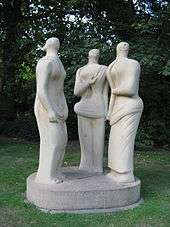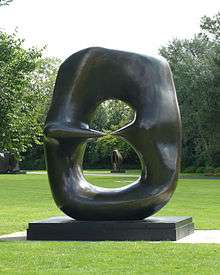Three Standing Figures 1947

Three Standing Figures 1947 (LH 268) is a large stone sculpture by Henry Moore. It was made in 1947-48, and exhibited at London County Council's first Open-Air Sculpture Exhibition at Battersea Park in 1948. Donated to the council, it has been exhibited at the park since 1950. It became a Grade II listed building in 1988.
Description
The 7 feet (2.1 m) high stone statue comprises three standing women, draped in flowing garments: two standing closer together, observed by the third. Each has rudimentary facial features, such as eye holes.
Moore's draped figures developed from a series of drawings inspired by his observations of people in underground bomb shelters during the Second World War. Somewhat reminiscent of the Three Graces, it may also draw from a drawing of the Three Fates made by Moore in 1948. In 1968, Moore commented that "it is as though the three women are standing there, expecting something to happen from the sky" Sylvester published an essay in The Burlington Magazine in 1948 with an unusual interpretation, as a family group: the protective mother, the stern father, and the child on the far right.
History
Moore began with a terracotta model made c.1945; its present location is unknown, but there are two known plaster copies, one at the Henry Moore Foundation and one on long term loan to the Tate Gallery. Moore also cast a bronze edition of four (plus one artist's copy) between 1948 and 1949; an additional artist's cast was made in 1985. Examples of these sculptures are held in the Smith College Museum of Art in Massachusetts and the Peggy Guggenheim Collection in Venice.
The work in Battersea Park was carved between August 1947 and May 1948 from Darley Dale sandstone, one of the last statues that Moore made from English stone. It was originally conceived to fulfil a commission from the Museum of Modern Art in New York, but it was instead exhibited at London County Council's first Open-Air Sculpture Exhibition at Battersea Park in 1948. (MOMA took instead a cast of Moore's first large bronze, the Family Group from The Barclay School in Stevenage, itself originally intended for Walter Gropius's Impington Village College.)
Moore was a member of the selection committee for the Open-Air Exhibition, and his sculpture was used on the publicity poster. It was sited in a prominent position, at the top of a slight rise in ground, with trees behind.
Moore's reputation grew dramatically from 1948, when he was a selected as Britiain's greatest living artist for the 24th Venice Biennale and won the sculpture prize.
The stone sculpture was lent for the Open-Air Exhibition in 1948, and then bought by the Contemporary Art Society and donated to London County Council. It has been permanently sited in Battersea Park in Battersea, London, in 1950, but has been moved from its original site.
References
| Wikimedia Commons has media related to Three Standing Figures - Henry Moore (LH 258, Battersea Park, London). |
- Three Standing Figures, Historic England
- Sculpture, Friends of Battersea Park
- Three Standing Figures 1947 (LH 268), Henry Moore Foundation
- Three Standing Figures, Tate Gallery
- Henry Moore: Sculptural Process and Public Identity, Tate Gallery
- Henry Moore and 'Sculpture in the Open Air': Exhibitions in London’s Parks, Jennifer Powell, Tate Gallery
- Henry Moore, Sculpting the 20th Century, Dorothy M. Kosinski, Julian Andrews; Yale University Press, 2001; ISBN 0300089929, p.278-9
Coordinates: 51°28′41″N 0°09′25″W / 51.4781°N 0.1569°W
